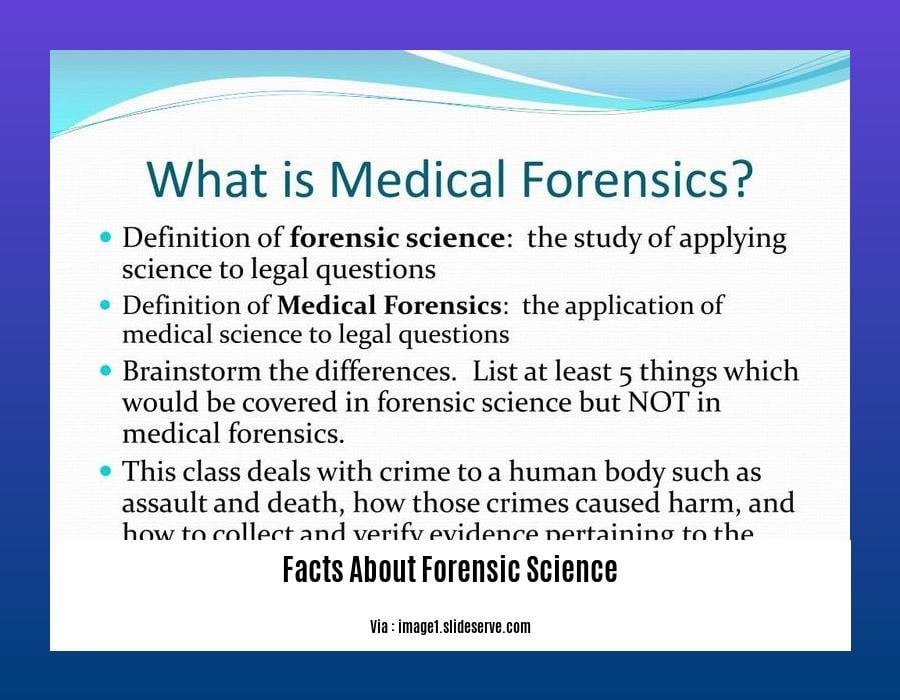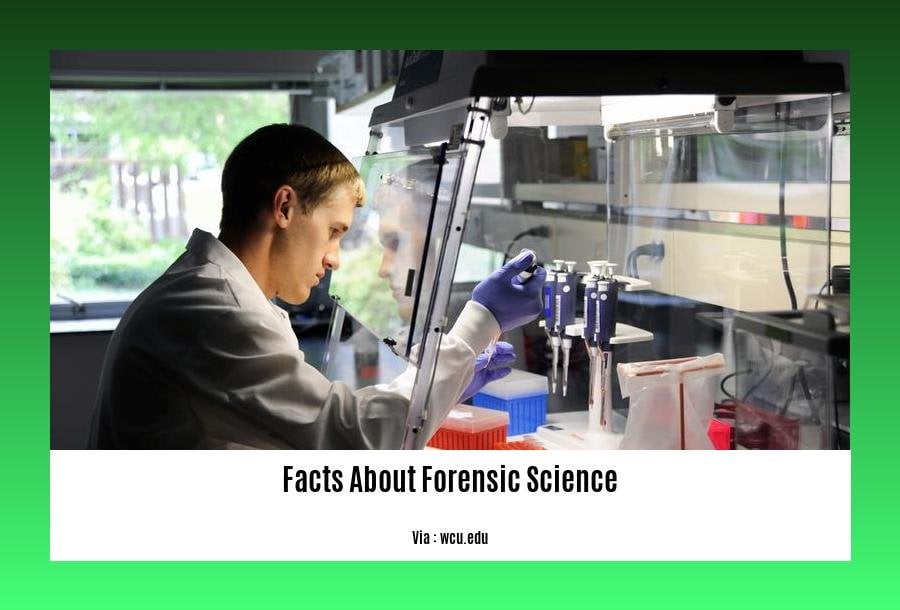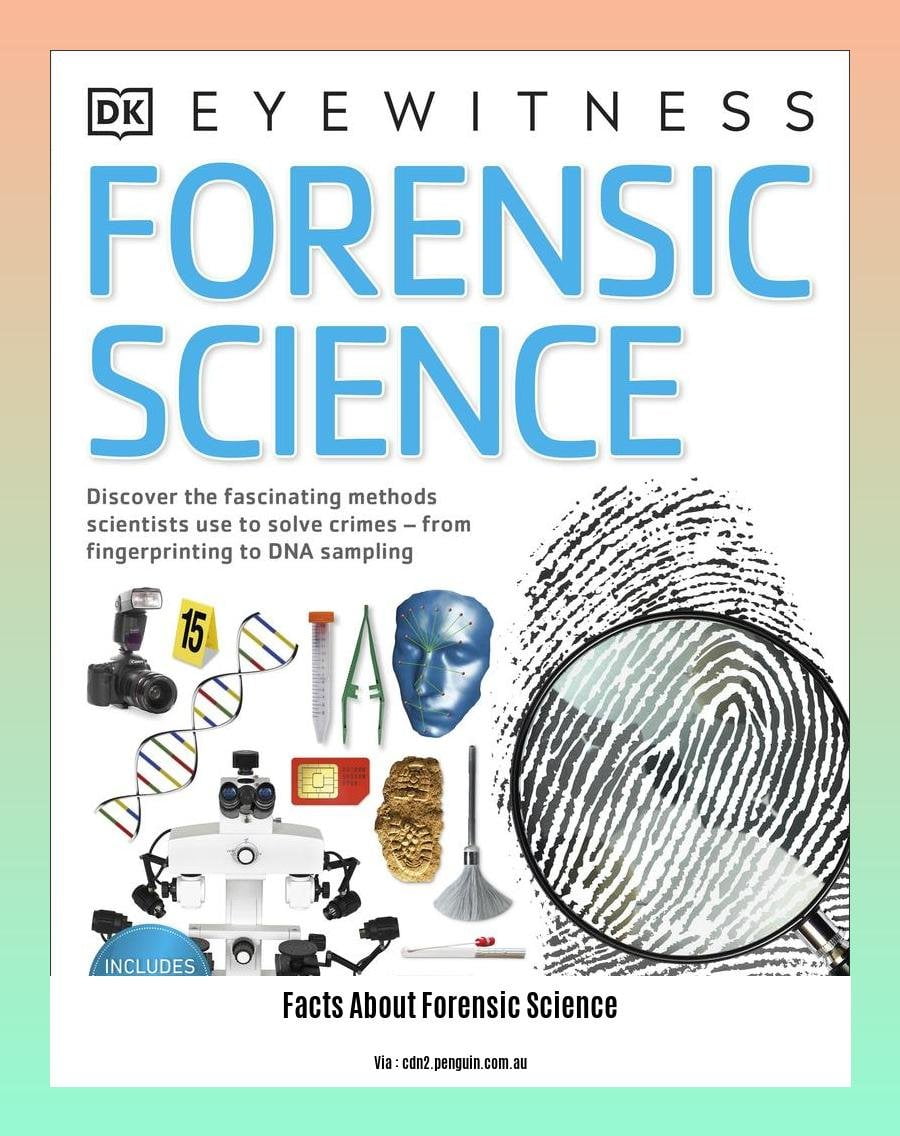Prepare to be captivated as we unveil the intriguing world of forensic science in our article, “Unveiling the Truth: Facts About Forensic Science That Will Amaze You.” Within these pages, you’ll encounter astonishing facts and revelations that showcase the incredible power of forensic techniques in uncovering the truth and delivering justice. Brace yourself for a journey through the fascinating realm of crime scene investigation, where scientific precision meets the pursuit of justice.
Key Takeaways:
Forensic science is the application of scientific methods to legal matters.
Teeth are the most reliable means of identifying a deceased individual.
Hair roots can be used to determine an individual’s gender.
Insects found on a body can help determine the approximate time of death.
Glitter, with its unique characteristics and difficulty in removal, can serve as valuable evidence in forensic investigations.
Facts about forensic science

Forensic science delves into the fascinating world where science meets justice, revealing hidden truths and shedding light on criminal investigations. From analyzing DNA fingerprints to scrutinizing trace evidence, forensic experts play a crucial role in piecing together the puzzle of crime scenes. Here are some intriguing facts that showcase the capabilities and significance of forensic science:
Revelations About Forensic Science
The Elusive Human Fingerprint: Did you know that no two people have identical fingerprints? This uniqueness makes fingerprint analysis a cornerstone of forensic science, allowing for the positive identification of individuals at crime scenes.
Teeth: A Strong Source of Identity: When traditional identification methods fail, teeth step into the spotlight. Forensic odontologists can extract valuable information from teeth, including DNA and unique dental patterns, to establish the identity of deceased individuals.
The Telling Tale of Hair Roots: A single hair root can provide a wealth of information to forensic scientists. By examining the root’s structure and analyzing its DNA, experts can determine an individual’s gender, ethnicity, and even hair color.
Insects: Nature’s Timeline: The presence of insects on a body can hold clues to the approximate time of death. Forensic entomologists study the life cycle and behavior of insects to estimate the post-mortem interval, providing crucial insights into the timeline of events.
Glitter: A Forensic Fingerprint: Often overlooked, glitter can be a valuable piece of forensic evidence. Due to its unique characteristics and resistance to removal, glitter particles can be traced and identified, linking perpetrators to crime scenes.
Conclusion
Forensic science is a captivating field that combines scientific precision with the pursuit of justice. These intriguing facts provide a glimpse into the remarkable capabilities of forensic experts who tirelessly work to uncover the truth and ensure that justice prevails.
Discover cool scientific facts that will amaze your friends! From the wonders of the universe to the intricacies of human physiology, there’s something for every curious mind.
Know more about the 10 facts about Australian bushfires that will help you understand this tragic event. Get the answers to questions about how frequent these fires are, what causes them, and how they impact Australia’s environment and wildlife.
Forensic science plays a crucial role in the criminal justice system by providing objective evidence and supporting legal proceedings.
Forensic science utilizes scientific methods to investigate and analyze evidence found at crime scenes. It profoundly impacts the criminal justice system, ensuring the fair and accurate administration of justice.
Key Takeaways:
Forensic science provides objective, scientific evidence that aids in solving crimes, convicting the guilty, and exonerating the innocent.
Forensic scientists meticulously examine evidence using advanced techniques like DNA analysis, ballistics, and trace evidence analysis to piece together the puzzle of a crime.
Forensic evidence is often presented in court to corroborate witness statements and physical evidence, helping juries to reach informed verdicts.
Forensic science advances the field of criminalistics by developing new methods and technologies for evidence collection and analysis, staying ahead of the curve in the fight against crime.
The Importance of Forensic Science in Court
Forensic science plays a pivotal role in the criminal justice system, serving as a cornerstone of modern criminal investigations:
Reliable Evidence: Forensic evidence provides a solid foundation for building a strong case. It offers unbiased, scientific data that can help determine the sequence of events and identify the perpetrator.
Exonerating the Innocent: Forensic science has been instrumental in exonerating wrongly convicted individuals through post-conviction DNA testing, proving their innocence and restoring their lives.
Trial Efficiency: By providing objective evidence, forensic science streamlines the legal process, reduces the need for lengthy trials, and facilitates swifter resolutions.
Public Confidence: A robust forensic science system instills public confidence in the criminal justice system, ensuring that justice is served accurately and efficiently.
Challenges Faced by Forensic Science
Despite its significant contributions, forensic science faces several challenges that demand attention:
Resource Constraints: Forensic science laboratories often grapple with limited resources, including funding, equipment, and personnel, which can hinder their ability to conduct timely and thorough analyses.
Human Error: While forensic scientists strive for accuracy, human error remains a possibility. Rigorous training, standardized protocols, and quality control measures are essential to minimize the risk of mistakes.
Keeping Pace with Technology: The rapid advancement of technology poses a challenge for forensic science to keep up with emerging methods and techniques. Continuous training and investment in cutting-edge technology are necessary to maintain the field’s effectiveness.
In conclusion, forensic science stands as an indispensable tool in the criminal justice system, providing objective evidence and supporting legal proceedings to ensure fair and accurate outcomes. Its dedication to scientific rigor, innovation, and the pursuit of truth makes it an invaluable asset in the fight against crime and the quest for justice.
Citations:
[1] “Forensic Science – United States Department of Justice”. U.S. Department of Justice, n.d. Web.
[2] “Exploring the Role of Forensic Science in Indian Criminal Justice System”. SSRN, n.d. Web.
Forensic scientists must adhere to strict protocols and standards to ensure the reliability and integrity of their findings.

Forensic science has garnered attention for its role in solving crimes and uncovering the truth. However, it’s crucial to understand that the credibility of forensic findings hinges on the meticulous adherence to strict protocols and standards by forensic scientists. These measures ensure that forensic evidence is analyzed and interpreted reliably, upholding the integrity of the justice system.
1. Ensuring Accuracy and Precision
Imagine a crime scene investigation where evidence is mishandled or contaminated, leading to erroneous results. To prevent such scenarios, forensic scientists follow stringent protocols to guarantee accuracy and precision in their work. They meticulously document every step of the evidence collection and analysis process, leaving no room for ambiguity or error.
2. Avoiding Contamination and Bias
Just like a chef carefully avoids cross-contamination in the kitchen, forensic scientists take every precaution to prevent evidence contamination. They wear protective gear, use sterile tools, and maintain a controlled environment to ensure that the integrity of the evidence is preserved. Additionally, they are trained to remain objective and unbiased throughout the entire process, eliminating the risk of personal bias influencing their findings.
3. Continuous Education and Training
The world of forensic science is constantly evolving, with new technologies and techniques emerging regularly. To keep pace with these advancements, forensic scientists undergo continuous education and training. They attend conferences, workshops, and seminars to stay updated on the latest developments in their field, ensuring that they possess the knowledge and skills necessary to conduct thorough and reliable analyses.
4. Quality Control and Peer Review
Just as a painter steps back to admire their artwork, forensic scientists subject their work to rigorous quality control measures. They meticulously review their findings, ensuring that they are accurate, complete, and supported by the evidence. Additionally, they often engage in peer review, where their work is scrutinized by other experts in the field, providing valuable feedback and ensuring the highest level of scientific rigor.
Key Takeaways:
- Reliability and integrity: Strict protocols and standards ensure the reliability and integrity of forensic findings, upholding the credibility of the justice system.
- Accuracy and precision: Meticulous documentation and adherence to protocols guarantee accuracy and precision in evidence analysis, preventing erroneous results.
- Avoiding contamination and bias: Protective gear, sterile tools, and controlled environments prevent contamination, while training eliminates the risk of personal bias influencing findings.
- Continuous education and training: Forensic scientists continuously update their knowledge and skills through conferences, workshops, and seminars, ensuring they’re abreast of the latest advancements.
- Quality control and peer review: Rigorous quality control measures and peer review ensure the accuracy, completeness, and scientific rigor of forensic findings.
Citations:
[1] Reliability and Validity in Forensic Science
[2] Quality Assurance and Quality Control in Forensic Science
Forensic science is constantly evolving with the development of new technologies and techniques, leading to advancements in crime-solving capabilities.
Ever thought how CSI Miami detectives solve crimes that seem impossible? Well, it’s not all magic and intuition! Forensic science, the scientific examination of evidence to aid in criminal investigations, has undergone remarkable advancements thanks to technology. Let me spill the tea on some mind-blowing innovations.
DNA Analysis:
DNA technology has revolutionized forensic science. DNA sequencing enables rapid identification, helping solve crimes and locate missing persons. It’s like having a unique genetic fingerprint for each individual!
Digital Forensics:
In the digital age, crimes aren’t just committed on the streets but also in the virtual world. Digital forensics uses cutting-edge methods to track down cybercriminals. They scour digital devices for evidence of hacking, identity theft, and online fraud.
Trace Evidence Analysis:
Even the tiniest piece of evidence can speak volumes. Microscopy and spectroscopy help forensic scientists examine trace evidence like fibers, hairs, and gunshot residue, helping them piece together the puzzle.
Chemical Analysis:
Chemistry plays a crucial role in forensic science. Chromatography and mass spectrometry identify and quantify chemicals, aiding in drug analysis, toxicology, and arson investigation.
Imaging Techniques:
3D scanning and photogrammetry create incredibly detailed 3D models of crime scenes. This helps investigators virtually reconstruct events, making crime scenes come to life.
Artificial Intelligence (AI):
AI algorithms can now sift through massive datasets of forensic data, identifying patterns and assisting in decision-making. It’s like having a super-smart sidekick helping solve cases.
Robotics and Automation:
Automated DNA extraction and analysis systems have sped up the process, reducing human error and increasing efficiency. Robots are like tireless assistants, working 24/7 to bring justice.
Key Takeaways:
- DNA sequencing enables rapid identification of individuals from DNA samples.
- Digital forensics combats cybercrimes, analyzing digital evidence.
- Microscopy and spectroscopy reveal secrets hidden in trace evidence.
- Chromatography and mass spectrometry identify chemicals in forensic samples.
- 3D scanning and photogrammetry create lifelike 3D models of crime scenes.
- AI algorithms help analyze vast forensic data and aid in decision-making.
- Automated DNA extraction and analysis systems increase efficiency and reduce errors.
Relevant Sources:
The Impact of New Technologies on Forensic Science
The Importance of Forensic Science Technology
FAQ
Q1: What is forensic science?
A1: Forensic science applies scientific methods and techniques to legal matters, particularly in criminal investigations, to analyze evidence and aid in solving crimes.
Q2: How reliable is teeth identification in forensics?
A2: Teeth provide the most reliable means of identifying a deceased individual compared to other body parts due to their unique characteristics and durability.
Q3: Can hair be used to determine an individual’s gender in forensics?
A3: Yes, hair roots, when analyzed using microscopic techniques, can be used to determine an individual’s gender, providing valuable information in forensic investigations.
Q4: How can insects assist in determining the time of death?
A4: By examining the species, developmental stage, and abundance of insects found on a body, forensic entomologists can estimate the approximate time since death, aiding in the investigation of homicides and suspicious deaths.
Q5: Why is glitter considered valuable evidence in forensic investigations?
A5: Glitter particles, due to their unique characteristics, adherence properties, and difficulty in removal, can be useful as forensic evidence. They can be recovered from crime scenes, clothing, and suspect’s possession, helping to link individuals to specific locations or activities.












